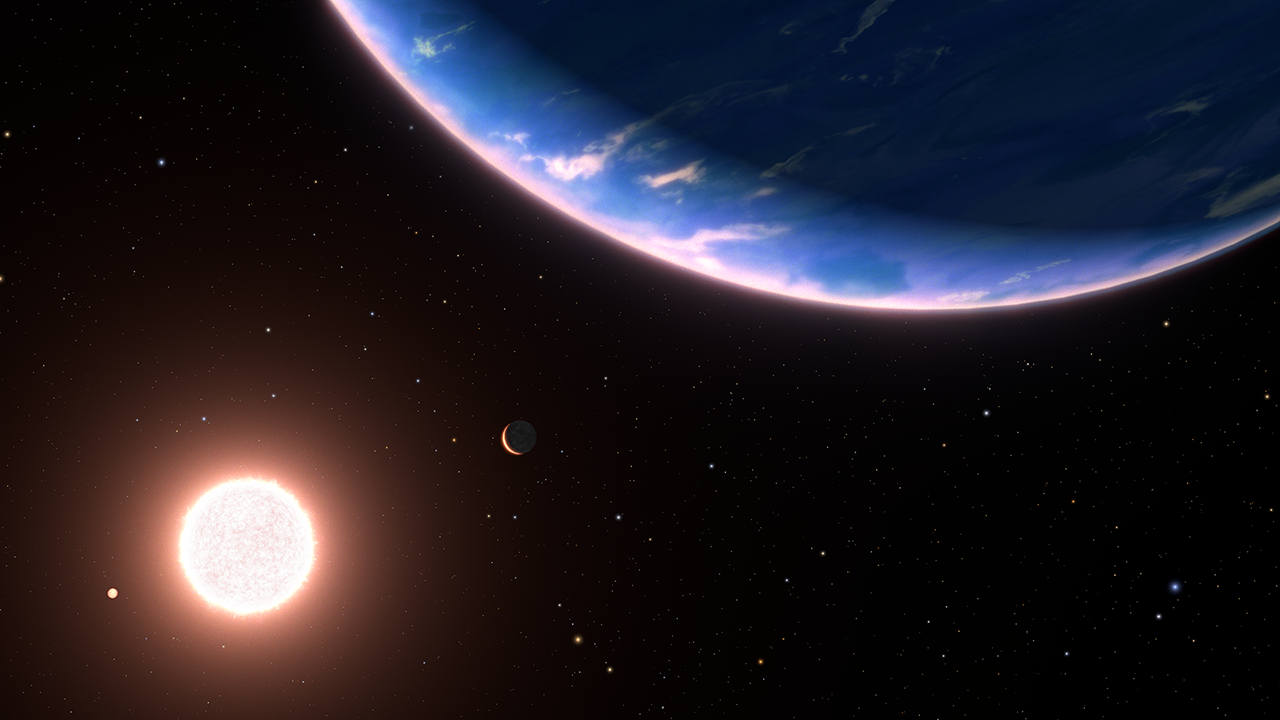Follow us on Google News (click on ☆)

Artistic representation of the exoplanet GJ 9827 d, the smallest exoplanet found to have an atmosphere with detected water vapor. It could be an example of a planet with a water-rich atmosphere. With a diameter of only about twice that of Earth, the planet orbits the red dwarf star GJ 9827. Two closer planets to the star on the left. The background stars are depicted as they would be seen with the naked eye looking towards the Sun. The Sun is too faint to be visible from this system.
Credit: NASA, ESA, Leah Hustak (STScI), Ralf Crawford (STScI)
The study, conducted by scientists from the University of Montréal, was published last September 12th in The Astrophysical Journal Letters.
"This would be the first time that we can directly demonstrate, through atmospheric detection, that planets with water-rich atmospheres exist around other stars," said Björn Benneke, a member of the research team, professor of astrophysics at UdeM, and researcher at the Trottier Institute for Exoplanet Research. This is an important step in better understanding the diversity of rocky planet atmospheres."
Two Possible Scenarios
It is still too early to determine if the atmosphere of GJ 9827 d contains a small amount of water vapor in an extended hydrogen-rich atmosphere, or if it is primarily composed of water, with lighter gases (such as hydrogen or helium) having evaporated under the effect of stellar radiation.
"Our observation program was designed to detect the planet's atmospheric molecules, and more specifically to search for the presence of water vapor," said Pierre-Alexis Roy, a student of Björn Benneke and lead author of the study. "Whether the water vapor is present in tiny amounts or is dominating, we have an interesting result!"
In the first scenario, the planet would have retained a hydrogen and water-rich envelope, somewhat like a miniature version of Neptune.
In the second scenario, it would resemble a larger and warmer version of Europa, Jupiter's moon, which has beneath its crust twice as much water as is found on Earth. In this case, as Björn Benneke pointed out, "it is quite possible that the planet GJ 9827 d is composed of half water and half rock: a small rock core surrounded by a thick layer of water vapor."
Smaller and Smaller Planets
"Until now, we have not been able to directly detect the atmosphere of such a small planet. We are gradually overcoming this technical challenge," added Björn Benneke. "As we study smaller and smaller planets, we expect to find worlds devoid of hydrogen, having atmospheres similar to that of Venus, dominated by carbon dioxide."
As the planet GJ 9827 d is as hot as Venus, with temperatures nearing 800°F (about 430°C), it would undoubtedly be an inhospitable and damp world if its atmosphere were primarily composed of water vapor.
Two Possible Formation Stories
If the planet has a residual water-rich atmosphere, it would have formed at a greater distance from its star, where the temperature is cold and water is available in the form of ice. In such a scenario, the planet would have moved closer to the star. The hydrogen would then have warmed and escaped from the planet's weak gravitational field.
In the other case, the planet would have formed close to the hot star and bear traces of water in its atmosphere.
Under the Space Telescopes' Lens
For this study, the Hubble telescope observed the planet during 11 transits in front of its star, spread over a period of three years. During these transits, the star's light is filtered through the planet's atmosphere and presents the spectral fingerprint of water molecules. If the planet is surrounded by clouds, they are low enough in the atmosphere for Hubble to detect the presence of water vapor above them.
The Hubble telescope's discovery paves the way for a more detailed study of the planet. For instance, it could be an interesting target for NASA's James-Webb Space Telescope and the search for other molecules using infrared spectroscopy.
The planet GJ 9827 d was uncovered by NASA's Kepler Space Observatory in 2017. It orbits a red dwarf star every 6.2 days. The star, GJ 9827, is located 97 light-years from Earth in the constellation of Pisces.